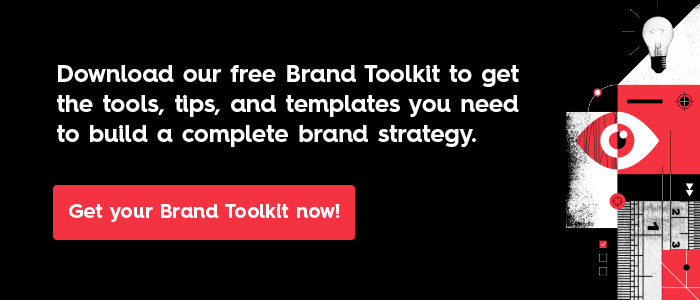According to a recent Gartner survey, 84% of business leaders say their brand identity needs an overhaul if they’re going to achieve their strategic goals in the next five years. Although it might sound shocking, we think 100% of brands should reevaluate whether or not their brand is working. Why? Because we see the symptoms of a weak brand in clients across every industry.
- It’s in those heated arguments over homepage messaging.
- It’s in the subpar results of a big paid campaign.
- It’s in the misalignment between marketing and sales.
Although these symptoms might take different forms, if you have a misaligned brand, the cracks in your foundation will inevitably show. (For the record, we know this because we’ve experienced these same issues.) Unfortunately, most of the dialogue around marketing success isn’t focused on brand. It’s all about growth hacking. Well, guess what? No matter what you do, you can’t growth hack your way out of a weak brand. Worse, if you neglect your brand in favor of quick wins, the long-term effects can be disastrous.

Growth Hacking Vs. Brand-Building: The Real Winner
In recent years, brands have become so focused on growth hacking they’ve lost sight of their long-term goals—and ignored major market shifts.
At a time when industries are more crowded and competitive, there are fewer and fewer ways to differentiate. Brand is one of the last remaining competitive advantages, but building a winning brand takes time and investment—even in economically challenging times.
For many, the short-term wins of growth hacking have become the priority, largely because of the pressure to produce results (and do more with less).
That doesn’t mean growth hacking is inherently bad, but its prevalence in the marketing world is an alarming trend. In many ways, it undermines marketing’s ultimate goal: to support and build a successful brand.
Brand-building is strategic; marketing is tactical.
When marketing tactics meant to advance your brand are replaced with growth hacking tactics that are wholly focused on financial targets (and don’t consider any of the potential implications to the brand), you put your brand (and your job) at risk.
Think of it this way: Growth hacking is, essentially, like being Weird Al Yankovic. You follow the latest trends, produce your own version, and get a hit now and then. But your work isn’t uniquely memorable. In essence, you’re a marketing cover artist. There’s nothing enduring, original, or permanent about your work.
To build a lasting brand, you need to be a Beyoncé. You need to stake your claim, make a powerful impact, and deliver on your value prop time and time again. Yes, brand is ever-evolving, but it grows from a strong foundation and identity—one that is supported through marketing.
So how do you shift your mentality from growth hacking to brand building—and get buy-in from everyone else?
How to Prioritize Brand Building Over Growth Hacking
You can’t build a brand alone; it requires everyone to be on board with the vision. Here are the steps you need to take to reimagine your approach from the ground up.
1) Stop creating content.
Did you just flinch reading that? We know why. Every marketer has been indoctrinated to think that if you’re not frantically publishing and producing content, you’re not doing marketing. We understand the instinct to feed the beast, but we’ve also seen what happens when you refuse to hit pause while re-centering your brand.
- The stories aren’t clear.
- The content isn’t compelling.
- The campaigns don’t connect.
So why would you keep sinking time, money, and resources into content that doesn’t work? Hit the pause button for a bit while you realign your strategy.
2) Document your brand strategy.
Your brand strategy is your plan for brand success. It includes your brand heart (purpose, vision, mission, values), competitors, personas, and more.
The strategy is your blueprint; marketing is the tool to build it. Yet many companies get ahead of themselves, jumping straight into marketing without taking time to establish a brand strategy (ourselves included). Thus, their marketing results are lackluster and inconsistent.
You need a documented brand strategy to keep everyone on the same page—literally.
Tip: If you haven’t created a proper brand strategy or haven’t done one thoroughly, here’s our step-by-step guide to do it. From there, flesh out your unique brand perspective to differentiate yourself in the marketplace. This thesis will influence every part of your marketing strategy, including any growth hacking tactics you may implement. (This is why it’s important to get your brand strategy locked down first, as any other decisions you make will be based on that core foundation.)
2) Align your content strategy to your brand strategy.
Your content strategy is an important part of your brand strategy, so the two should always be aligned. (You’ll know they’re aligned if you can identify how every piece of content supports your brand.)
As you brainstorm fresh brand storytelling ideas, ask yourself:
- Does this content reflect our brand’s core values? People want to connect with brands run by real people who stand behind real causes. Creating content that reflects your culture and your people is key. (Here are a few brands who do this well.)
- Are we writing about appropriate themes? Don’t try to newsjack or chime in on conversations that are outside your lane.
- Are we accurately representing ourselves (in voice, tone, visual identity, etc.)? If your brand identity needs updating, find out how to identify your brand voice, design a cohesive visual identity, and come up with content ideas.
These are the types of crucial questions that will ensure you’re keeping your brand front of mind—even as you pursue growth hacking techniques.
Tip: If you haven’t documented a fleshed-out content strategy, use our free toolkit to get yours on paper.
4) Designate someone to guard the brand.
Every ship needs a captain; every brand needs a steward. That means someone who can make the big decisions, question whether business decisions align to the brand, and lead with resolve. This can be challenging when sales are down and people need someone to blame. But it is important to have someone who can stand strong and lead with conviction.
Sometimes this role will be played by a founder or Chief Brand Officer. Sometimes it’s the CMO or, hell, even the VP of Sales. Regardless, you need someone who will prioritize brand above all.
Tip: Larger companies may have multiple people in charge of brand. If you are working at that scale, see our tips to build a designated brand team. Also, remember that consistency is key when it comes to establishing and promoting a successful brand. Use our brand checklist to ensure that any content that goes out the door accurately reflects your brand identity and personality.
How to Put Your Brand First
As previously mentioned, we are not advocating for abandoning all growth hacking tactics. But it’s important to prioritize and protect your brand as you shape your strategies. Naturally, this process does require a degree of patience. Growth hacking is satisfying because there’s a short-term payoff, but building a brand takes time. For many, it can feel like a leap of faith, and in some ways it is. You may be in the dark for a bit, and it can take time to see the payoff.
All that to say, we know that it can be difficult to shift your mindset—no matter how much you want to prioritize brand. If you’re dealing with a certain level of misalignment or a lack of buy-in from others, it can help to bring in outside support. (If you’re curious about how we do things, see our brand strategy FAQs, and find out how we help score real results for our clients.)
Otherwise, if you’re keeping your efforts in-house, just remember that nothing is permanent. You can always shift strategy, re-evaluate according to your latest data insights, and experiment in smaller, less risky ways. It just takes patience and persistence.





